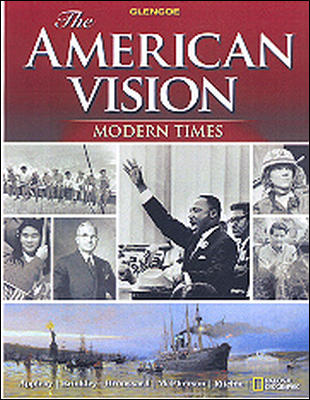
The American Vision Modern Times © 2010Chapter 7: Becoming a World Power, 1872-1917Chapter OverviewsThis chapter traces the rise of the United States as a world power. Section 1 identifies the attitudes and actions that transformed the United States into a world power. By the 1880s the western frontier was finally filling up, and American business leaders began looking overseas to find new markets. Increased European imperialism led many Americans to justify expansion with the idea of Anglo-Saxonism—the belief that it was the nation's destiny to spread its civilization to other people. New markets were forced opon first in Japan, when the United States made a show of force, and then in Hawaii, when American business leaders led a successful campaign for Hawaiian annexation. In Latin America, leaders attempted to increase American influence. Meanwhile, the United States became increasingly assertive in foreign affairs. As Americans became more willing to risk war in defense of overseas markets, interest in a powerful navy and overseas bases grew. Section 2 describes the Spanish-American War. In 1895 many Americans sided with Cuban rebels in an uprising in the Spanish colony of Cuba. Americans had close economic and trade ties to Cuba, and yellow journalism played to their sympathies. President William McKinley tried to negotiate a peaceful end to the rebellion. However, when the U.S.S. Maine exploded off the coast of Cuba, the press blamed Spain, and Americans called for war. The U.S. Navy proved its superiority over the Spanish fleet, while American troops led successful ground attacks. Spanish resistance ended with the surrender of the Cuban city of Santiago. Under the terms outlined in the Treaty of Paris, Cuba became an independent country, and Spain ceded Guam and Puerto Rico and sold the Philippines to the United States. Despite arguments from anti-imperialists, the United States annexed the Philippines along with Guam and Puerto Rico. With the events of the Spanish-American War, the United States established itself as an imperial power. Section 3 explains how the United States wielded its influence on the world stage under President Theodore Roosevelt. After President McKinley's assassination, young and energetic Vice President Theodore Roosevelt took charge. Because Roosevelt intended to make the United States a world power, his administration involved itself in the politics of foreign nations. In Asia, American leaders worked to maintain an Open Door Policy—full access to China's lucrative markets. Roosevelt gained worldwide recognition for his role in negotiating a peace between Japan and Russia. He used a "big stick" policy to secure the right to build the Panama Canal, while the Roosevelt Corollary warned foreign powers that the United States would intervene to maintain stability in Latin American. President William Taft continued Roosevelt's mission of enhancing American influence in the Western Hemisphere, but his dollar diplomacy put less emphasis on military strength and more emphasis on helping Latin American and Asian industry. President Wilson believed in "moral diplomacy" and tried to encourage democracy in Latin America, but he still ended up sending troops to Mexico in 1914. |  |















